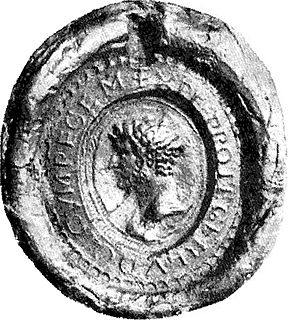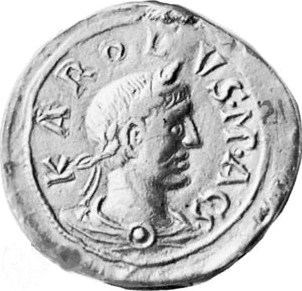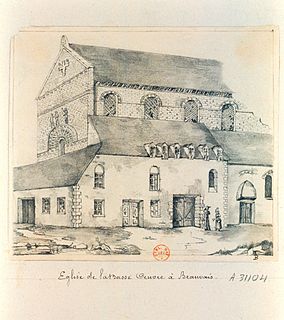Wilbert [lower-alpha 1] (died 889) was the archbishop of Cologne from 870 until his death.

The Archbishop of Cologne is an archbishop representing the Archdiocese of Cologne of the Catholic Church in western North Rhine-Westphalia and northern Rhineland-Palatinate in Germany and was ex officio one of the electors of the Holy Roman Empire, the Elector of Cologne, from 1356 to 1801.
Wilbert was a priest in Cologne Cathedral when archbishop Gunther was excommunicated and deposed. Charles the Bald, king of West Francia, tried to install his own palatine cleric, Hilduin, as archbishop. [1] He failed when Louis the German, king of East Francia, sent Liutbert, archbishop of Mainz, to consecrate the priest Wilbert instead. On 7 January 870, Wilbert was acclaimed by Liutbert with the consent of the clergy and people of the diocese, with Odilbald of Utrecht assisting the consecration. Pope Hadrian II sent an embassy under Wibod, bishop of Parma, carrying his letters of acceptance. [2] His appointment was made rapidly in order to foil any attempt by Louis's rival, Charles the Bald, to fill the vacant see with a candidate favourable to him. [3] Charles did succeed in placing Bertulf in power in the archdiocese of Trier.

Cologne Cathedral is a Catholic cathedral in Cologne, North Rhine-Westphalia, Germany. It is the seat of the Archbishop of Cologne and of the administration of the Archdiocese of Cologne. It is a renowned monument of German Catholicism and Gothic architecture and was declared a World Heritage Site in 1996. It is Germany's most visited landmark, attracting an average of 20,000 people a day, and currently the tallest twin-spired church at 157 m (515 ft) tall, second in Europe after the Ulm Cathedral and third in the world.

Charles the Bald was the king of West Francia (843–877), king of Italy (875–877) and emperor of the Carolingian Empire (875–877). After a series of civil wars during the reign of his father, Louis the Pious, Charles succeeded, by the Treaty of Verdun (843), in acquiring the western third of the Carolingian Empire. He was a grandson of Charlemagne and the youngest son of Louis the Pious by his second wife, Judith.
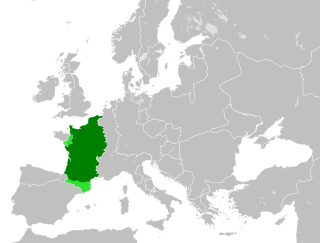
In medieval historiography, West Francia or the Kingdom of the West Franks was the western part of Charlemagne's Empire, ruled by the Germanic Franks that forms the earliest stage of the Kingdom of France, lasting from about 840 until 987. West Francia was formed out of the division of the Carolingian Empire in 843 under the Treaty of Verdun after the death of Emperor Louis the Pious and the east–west division which "gradually hardened into the establishment of separate kingdoms ... of what we can begin to call Germany and France".
Wilbert received the contested pallium from Pope Hadrian in 875. He extended the cathedral for use in holding synods, held the first provincial synod of his province there in 887, and was the first archbishop buried in the cathedral in 889. On 26 September 870, a German synod, attended by Liutbert and Bertulf, was held in Cologne with all the bishops of Saxony. [4] The cathedral, desecrated by Gunther, was reconsecrated to Saint Peter.

The pallium is an ecclesiastical vestment in the Roman Catholic Church, originally peculiar to the Pope, but for many centuries bestowed by the Holy See upon metropolitans and primates as a symbol of their conferred jurisdictional authorities, and still remains papal emblems. Schoenig, Steven A., SJ. Bonds of Wool: The Pallium and Papal Power in the Middle Ages (Washington, DC: The Catholic University of America Press, 2017. ISBN 978-0-8132-2922-5. In its present form, the pallium is a long and "three fingers broad" white band adornment, woven from the wool of lambs raised by Trappist monks. It is donned by looping its middle around one's neck, resting upon the chasuble and two dependent lappets over one's shoulders with tail-ends on the left with the front end crossing over the rear. When observed from the front or rear the pallium sports a stylistic letter 'y'. It is decorated with six black crosses, one near each end and four spaced out around the neck loop. At times the pallium is embellished fore and aft with three gold gem-headed stickpins. The doubling and pinning on the left shoulder likely survive from the Roman pallium. The pallium and the omophor originate from the same vestment, the latter a much larger and wider version worn by Eastern Orthodox and Eastern Catholic bishops of the Byzantine Rite. A theory relates origination to the paradigm of the Good Shepherd shouldering a lamb, a common early Christian art image — but this may be an explanation a posteriori, however the ritual preparation of the pallium and its subsequent bestowal upon a pope at coronation suggests the shepherd symbolism. The lambs whose fleeces are destined for pallia are solemnly presented at altar by the nuns of the convent of Saint Agnes and ultimately the Benedictine nuns of Santa Cecilia in Trastevere weave their wool into pallia.

A synod is a council of a church, usually convened to decide an issue of doctrine, administration or application. The word synod comes from the Greek σύνοδος (sýnodos) meaning "assembly" or "meeting", and it is synonymous with the Latin word concilium meaning "council". Originally, synods were meetings of bishops, and the word is still used in that sense in Catholicism, Oriental Orthodoxy and Eastern Orthodoxy. In modern usage, the word often refers to the governing body of a particular church, whether its members are meeting or not. It is also sometimes used to refer to a church that is governed by a synod.

The Duchy of Saxony was originally the area settled by the Saxons in the late Early Middle Ages, when they were subdued by Charlemagne during the Saxon Wars from 772 and incorporated into the Carolingian Empire (Francia) by 804. Upon the 843 Treaty of Verdun, Saxony was one of the five German stem duchies of East Francia; Duke Henry the Fowler was elected German king in 919.
On 4 July 876, Wilbert led an embassy of German bishops to Charles the Bald's synod at Ponthion to claim for Louis the German a part in the inheritance of the late Emperor Louis II of Italy. The synod rebuffed them, since Pope John VIII was a strong supporter of Charles, and forced them to take an oath of fidelity to Ansegis, one of Charles's churchmen, whom the pope had appointed legate for all Europe north of the Alps. [5] After Louis the German's death, Charles the Bald disputed the right of the former's heir, Louis the Younger, to receive Louis's share of Lotharingia. On 7 October 876, Charles was preparing a surprise attach on Louis the Younger, when Wilbert discovered the plot and warned Louis. [6] The ensuing battle was a defeat for Charles. [7]

Ponthion is a commune in the Marne department in north-eastern France.

Louis II, sometimes called the Younger, was the king of Italy and Holy Roman Emperor from 844, co-ruling with his father Lothair I until 855, after which he ruled alone. Louis's usual title was imperator augustus, but he used imperator Romanorum after his conquest of Bari in 871, which led to poor relations with the Eastern Roman Empire. He was called imperator Italiae in West Francia while the Byzantines called him Basileus Phrangias. The chronicler Andreas of Bergamo, who is the main source for Louis's activities in southern Italy, notes that "after his death a great tribulation came to Italy."

Pope John VIII was Pope from 14 December 872 to his death in 882. He is often considered one of the ablest pontiffs of the 9th century.
Cologne was pillaged and razed by Vikings in 881–882, but Liutbert of Mainz assisted in rebuilding it. Wilbert and Henry of Franconia met the Viking leader Godfrid, Duke of Frisia, at Herespich, an island in the confluence of the Rhine and the Waal. At the meeting, Godfrid was killed and Wilbert persuaded Gisela, his wife, to leave the island and pursue a policy of peace. [8]

Vikings were Norse seafarers, mainly speaking the Old Norse language, who, from the late 8th to late 11th centuries, raided and traded from their Northern European homelands across wide areas of Europe, and explored westwards to Iceland, Greenland, and Vinland. The term is also commonly extended in modern English and other vernaculars to the inhabitants of Norse home communities during what has become known as the Viking Age. This period of Nordic military, mercantile and demographic expansion constitutes an important element in the early medieval history of Scandinavia, Estonia, the British Isles, France, Kievan Rus' and Sicily.
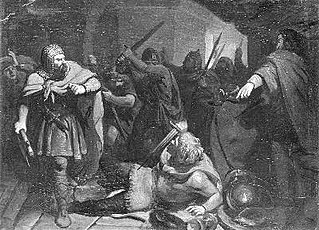
Godfrid, Godafrid, Gudfrid, or Gottfrid was a Danish Viking leader of the late ninth century. He had probably been with the Great Heathen Army, descended on the continent, and became a vassal of the emperor Charles the Fat, controlling most of Frisia between 882 and 885.
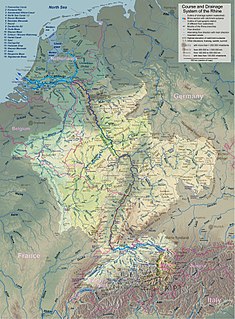
The Rhine is one of the major European rivers, which has its sources in Switzerland and flows in a mostly northerly direction through Germany and the Netherlands, emptying into the North Sea. The river begins in the Swiss canton of Graubünden in the southeastern Swiss Alps, forms part of the Swiss-Liechtenstein, Swiss-Austrian, Swiss-German and then the Franco-German border, then flows through the German Rhineland and the Netherlands and eventually empties into the North Sea.
